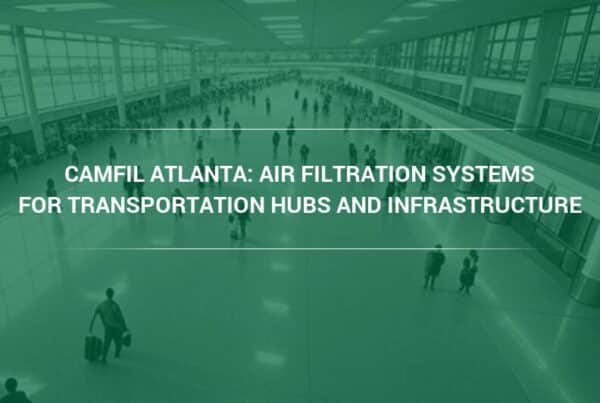Discussions of the benefits of cleaner air often highlight the impact of both indoor and ambient (outdoor) air pollution on human health, particularly the health of our lungs and hearts, and on the environment. However, the benefits of breathing clean air extend far beyond reduced instances of respiratory irritation and diseases.
An important but often overlooked benefit of clean indoor air is its positive effects on worker productivity. In this article, Camfil air quality experts discuss how air quality impacts productivity and how to achieve clean air in commercial office spaces.
How Does Air Quality Affect Worker Productivity?
Despite its significance, the quality of indoor air at workplaces is often neglected while trying to enhance employee productivity. Research suggests that maintaining clean indoor air can have a substantial impact on people’s performance at work. Let’s take a look at a handful of studies published in recent years on the correlation between air quality and productivity.
Modern research clearly shows that the quality of the air filter can make a noticeable difference. The higher the volume of air pollution that comes into a building, the more people will suffer from bad air symptoms like headaches, irritated eyes, fatigue, difficulty concentrating, etc., resulting in less work getting accomplished.
Study: Workplace Productivity Decreases When Employees Are Exposed to Air Pollution
A study conducted in China looked at output data from two travel agency call centers in Shanghai and Nantong alongside data about air quality from the Chinese Air Quality Index.
Linking outdoor air quality and weather to each worker’s output, a study found that higher air pollution results in a reduction of daily calls. Specifically, a 10-unit rise in the Air Quality Index resulted in a 0.35% decrease in calls handled per worker.
Air pollution reduction could drive increased productivity in the Chinese service sector by billions of dollars per year, as per researcher estimations. Similar effects may be witnessed in metropolitan areas worldwide.
Study: Air Pollution Negatively Affects All Domains of Cognitive Function
An experimental study tested the impact of air quality on the cognitive performance of office workers in an environmentally controlled office space over the course of six eight-hour work days. Participants were blinded to test conditions as they were exposed to different levels of VOCs (volatile organic compounds) and CO2, as well as different rates of ventilation.
This study tested nine different domains of cognitive function, each of which is an important component of the critical thinking and problem-solving required in modern office workplaces:
- Basic Activity Level — the overall ability to make decisions.
- Applied Activity Level — the ability to make decisions oriented to overall goals.
- Focused Activity Level — the ability to focus on the current task or situation.
- Task Orientation — the ability to make decisions that contribute to task completion.
- Crisis Response — the ability to plan, strategize, and stay prepared in emergency situations.
- Information Seeking — the ability to gather necessary information from a variety of available sources.
- Information Usage — the ability to use provided and gathered information to reach goals.
- Breadth of Approach — the ability to consider multiple dimensions in decision-making and use a variety of approaches to achieve goals.
- Strategy — the ability to optimize information and planning to reach well-integrated solutions.
Higher air quality was found to improve cognitive function in all nine domains tested. Cognitive scores were on average 61% higher on days with better air quality and 101% higher on days with both improved air quality and ventilation. Typical office conditions showed poorer cognitive performance.
Study: Poor Air Quality Means Getting Less Done, and Personal Computers Contribute to Poor Air Quality
Another study highlighted the impact of personal computers on air quality and the resulting dip in productivity. During two 8-week periods, office workers were studied to observe the impact on productivity when removing common indoor air pollution sources and increasing the per-person supply rate of clean outdoor air. The study concluded that poor indoor air quality can reduce office productivity by 6-10%.
Another important finding from this study was that commonly used brands and models of personal computers used in offices are responsible for generating harmful pollutants and contributing to poor indoor air quality. This means that even in areas where ambient air quality is good, the work conducted in offices is responsible for poor indoor air quality.
Study: Clean Air May Prevent Cognitive Decline in Elderly Populations
Another Chinese study collected the language and math test scores of more than 20,000 people aged ten or older in China over a 4-year period between 2010 and 2014. They then compared this data with air pollution records during the same time period, taking a particular interest in particulate matter (PM), nitrogen dioxide (NO2), and sulfur dioxide (SO2).
Exposure to air pollution over the long term can lead to a decline in cognitive performance such as attention, recall, and ability to process new information. Researchers report a reduction in verbal and math test scores. Importantly, the effects of air pollution on poor cognition were more pronounced as the age of participants increased, indicating a possibility that air pollution may accelerate the cognitive decline associated with natural aging. This effect was especially pronounced in men and individuals with low educational attainment.
The Role of Premium Air Filters in Improving Productivity
Air filters in our ventilation systems are crucial to protect our health and well-being by cleansing outdoor air. Not all filters are created equal – some are more effective at trapping harmful particles and gases and maintain the rated efficiency for longer. Choosing the right one is essential to ensure productivity and safety indoors is highly dependent on the specifics of the building and the needs of the company.
Key considerations for choosing the right combination of air filters for your office include:
- Building size and usage
- Pollution sources and levels
- Specific air quality goals
- Industry regulations and standards for air quality
- Operational cost
- Maintenance requirements
Furthermore, air filters and air purifiers in offices should target both gaseous and particulate pollutants, as both types of air pollutants affect employee health and productivity.
The City M air purifier is an ideal solution to improve indoor air quality in offices for several reasons:
- The City M is equipped with HEPA air filtration, featuring individually tested filters certified to remove 99.995% of the most penetrating particle size. This efficient system helps safeguard employees from COVID-19 transmission and other airborne diseases while also shielding them from even the smallest particulate matter and harmful gaseous pollutants.
- The City M functions independently of the HVAC system and plugs directly into standard electrical outlets, meaning that it is accessible to all buildings, regardless of existing air handling units.
- The City M is quiet, so it will not cause distractions in an office.
About Camfil Clean Air Solutions
For more than half a century, Camfil has been helping people breathe cleaner air. As a leading manufacturer of premium clean air solutions, we provide commercial and industrial systems for air filtration and air pollution control that improve worker and equipment productivity, minimize energy use, and benefit human health and the environment. We firmly believe that the best solutions for our customers are the best solutions for our planet, too. That’s why every step of the way – from design to delivery and across the product life cycle – we consider the impact of what we do on people and on the world around us. Through a fresh approach to problem-solving, innovative design, precise process control, and a strong customer focus we aim to conserve more, use less and find better ways – so we can all breathe easier.
The Camfil Group is headquartered in Stockholm, Sweden, and has 30 manufacturing sites, six R&D centers, local sales offices in 35+ countries, and about 5,600 employees and growing. We proudly serve and support customers in a wide variety of industries and in communities across the world. To discover how Camfil USA can help you to protect people, processes and the environment, visit us at www.camfil.us/
##
Media Contact:
Lynne Laake
Camfil USA Air Filters
T: 888.599.6620
E: Lynne.Laake@camfil.com
F: Friend Camfil USA on Facebook
T: Follow Camfil USA on Twitter
Y: Watch Camfil Videos on YouTube
L: Follow our LinkedIn Page
Sources:



